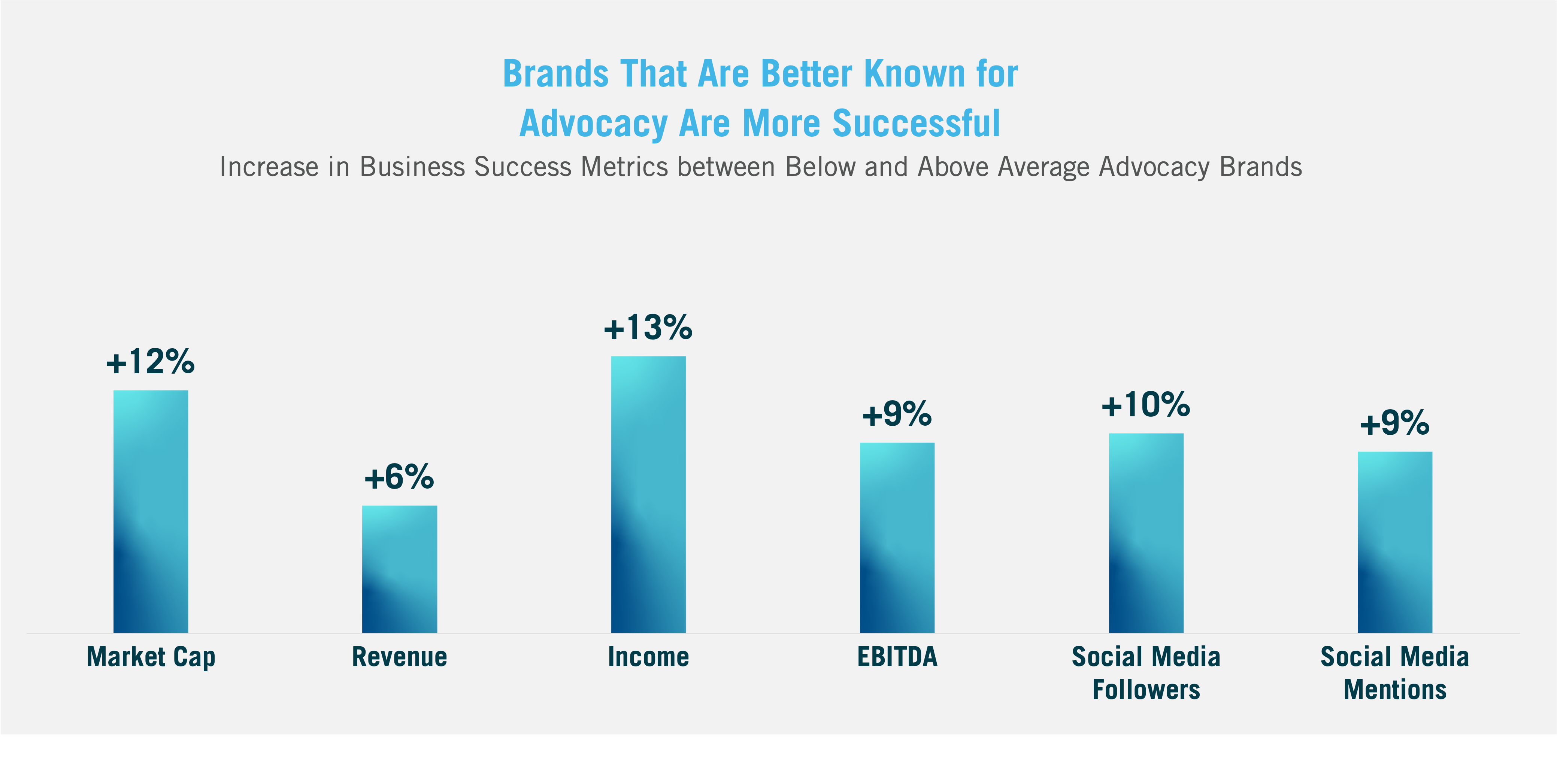
How to Maximize the Benefits and Avoid the Pitfalls of Corporate Advocacy
by Jeremy Cochran and Eric Scheer
Corporate Advocacy: From a Position of Strength
Willingly or unwillingly, today’s brands have stepped into the spotlight as unlikely corporate advocates of social causes, such as LGBTQ+ rights, environmental conservation and reproductive rights. This coincides with a waning sense of faith in traditional leadership platforms, especially when it comes to effecting societal change. As such, we see consumers’ expectations shifting – it’s not just about products and experiences, it’s about products, experiences, communications and cultural influences that all combine to make a positive impact.
In some cases, consumer expectations for corporate advocacy – that is, corporations’ contributions to, and support of, broader causes – push brands into causes and concerns that transcend the products and services they sell. Consider Levi’s stand on gun control or Patagonia’s push for sustainability. These initiatives have come to define both brands in ways that aren’t directly connected to selling jeans and jackets (and yes – we’ll talk about Bud Light in a minute).
Long story short, corporate advocacy has become an essential component of what defines success for a modern brand. In our approach to assessing brand strength, we use five key metrics to determine market relevance and competitive momentum. We’ve found that corporate advocacy plays a critical role in driving a brand’s momentum but in a world of shifting perspectives, building a growth strategy that effectively leverages advocacy can be extremely challenging. Even risky.
As we’ve all seen in recent years, corporate advocacy can breed controversy. There’s no getting around it. However, with careful planning, strategic assessment and goal-setting, brands can successfully embrace advocacy while minimizing and managing potential risks.
But what, exactly, do we mean by “successfully embracing corporate advocacy”?
A recent Harvard Business Review (HBR) article describes success in this area as a “long-term competitive advantage” and increased cultural relevance. Moreover, the article frames success as the result of intentional strategies and processes that help manage short-term controversy.1
With that in mind, let’s take a closer look at why advocacy is so important for brands today.
Corporate Advocacy: Strong Link
Burke’s research on brand growth shows a strong link between advocacy and increased topline revenue (Figure 1). When consumers see brands advocating for issues they believe in, those brands tend to have stronger business outcomes as well as a stronger social media presence than brands rated lower in terms of advocacy. Furthermore, these brands often show stronger year-over-year growth than their competitors, demonstrating the link between advocacy and business success.

Results based on Burke’s Brand Strength Research Survey conducted in November 2022 (n=3,206), which measured perceptions and behaviors related to 81 brands. Brand Advocacy is measured as a composite score consisting of two attributes asked of survey respondents about brands: “Is environmentally responsible” and “Is a brand that cares about broader social issues”. Scores were aggregated by brand and financial performance captured through SEC filings. Values represent difference in percentage of brands’ share within the total for the category
According to a recent study, a majority of surveyed consumers agree that it’s important for companies to think beyond their profits. In fact, 94% of consumers state that it’s important for companies to have a strong purpose and 83% say companies should only profit if they also deliver a positive impact.2
Similarly, a series of HBR surveys found that when consumers are aware of a brand’s societal initiatives, loyalty to and trust in that brand increase.3 The surveys also found that employees exhibit greater trust and loyalty – as well as more positive word of mouth – when a chief executive’s social-issue commitments are backed by action.
Moreover, Burke’s research also suggests that younger consumers (i.e., Gen Z and Millennials) are more attuned to brands’ level of corporate advocacy than older consumers. These findings correspond to broader research indicating that a brand’s stances and corporate practices are a bigger driver of purchase choice for younger consumers.4 However, this isn’t to say that older consumers care less about these issues; indeed, controlling for political alignment, there is little difference in attitudes across generations. Rather, younger generations are simply more likely to expect more from brands in terms of pursuing these issues. And, assuming their attitudes stay this way, their expectations will only increase over time.5
Unfortunately, we see plenty of examples where brands miss the mark in terms of what and how they’re advocating. We all know about Bud Light’s poorly received attempt to court a more progressive audience by sponsoring transgender social media influencer Dylan Mulvaney in 2022. Earlier that same year, Target faced accusations of abandoning its decades-long advocacy for the LGBTQ community when it moved and removed Pride merchandise in response to in-store protests. Fueled by the pervasive power of social media, these situations negatively affected both brands’ image and their topline.
As mentioned, advocating for an issue/cause never comes without some risk. But remaining silent on societal issues presents risks as well. Based on our own research – as well as the lessons we’ve learned from observing other brands – it’s clear that when brands don’t actively manage the conversation on their social positions, they run the risk of losing engaged consumers to more vocal competitors. Moreover, silent brands will miss out on opportunities to build a sense of trust and rapport with passionate consumers, who often have the highest potential for loyalty.
For example, in 2018, Nike showcased NFL quarterback Colin Kaepernick in its advertising campaigns during a time of deep polarization around Kaepernick’s decision to kneel during the national anthem (as a protest of racial inequality). While Nike initially lost 3% of its stock value and videos emerged of people burning their shoes in protest, within a month the stock recouped that loss and grew by 5%.6 In the end, Nike did not suffer long-lasting financial implications and the brand likely benefitted from a favorable impression among consumers who were engaged by this issue. Moreover, it’s likely these same consumers will demonstrate continued loyalty to Nike for supporting their beliefs.
Corporate Advocacy: Finding the Right Path
As a brand, how do you “do advocacy” the right way?
After studying brands that have successfully embraced advocacy as part of their growth strategy, we’ve identified six key recommendations that can help you navigate the complexities of corporate advocacy, while managing risk and maximizing a strong, authentic presence. While the exact path forward for any brand is complex and varied, these recommendations can help maximize the benefits and reduce risks.
Recommendation 1: Weigh the Effect of Your Corporate Advocacy on Key Audiences.
Three main groups will determine if your corporate advocacy efforts are a success:
Current consumers – those who can promote and buy more of your product.
Potential consumers – those who will be drawn to your brand by your advocacy efforts.
Your employees – those who will ensure your brand delivers authentically.
Know these audiences and their values. For both consumer groups, it’s helpful to understand the degree to which your efforts will influence their purchase decisions. This information should inform your choice of issue and its place in your overall strategy. Consider primary and secondary research that can provide an objective measurement of these audiences’ beliefs and values.
For employees, you will want to know their opinions but it is also important to identify who is driving the success of your brand and who will be most affected by your decision. While corporate advocacy can increase loyalty and engagement, if employees feel at odds with their employer, they may disengage or leave. In all cases, your objective is to anchor your decision in data, while remaining sensitive to your brand’s values and the social context. So, make a plan to reach out to these groups early and regularly.
Recommendation 2: Build Authenticity into Your Corporate Advocacy Strategy.
For modern consumers, authenticity is of the utmost importance. It is closely related to brand trust, which is a foundational element of brand strength. Consumers can quickly identify when companies are wading into waters where they have no knowledge or experience, rightly tagging them as phony or out of their element. Consider advocating for issues that align with your corporate responsibilities or brand values. Issues aligned with the business you are in and the benefit you provide are more naturally authentic to your brand.
Start with your brand’s value proposition and brand purpose; if these elements are missing or outdated, refresh them. Clear articulations of your brand’s DNA will be essential to identifying the link between your brand and its cause. Consider Nike – known for supporting athletes – getting behind Colin Kaepernick, or Dawn dish soap as an icon for cleanliness being used to clean toxic chemicals from marine birds. These brands have a logical association with their causes.
Recommendation 3: Build Relationships to Ensure Relevance.
Do your homework and make sure you pursue advocacy in a truly helpful way. Start by creating an organizational structure and identify the people who will manage your commitment for the long term. Encourage your leaders to meet with leaders of the cause you choose and, together, identify what would truly help and what would potentially just create a distraction.
For instance, many companies have drawn attention to certain issues without having a true beneficial impact. It’s sometimes called “woke-washing” – and consumers have become more adept at identifying it, or at times misidentifying it when there is authentic, positive corporate intent.
Recommendation 4: Balance Impact with Visibility.
Despite the inherent value of supporting needed causes, your corporate advocacy efforts must also provide an effective means of promoting your brand’s image and reputation – otherwise your efforts will not be justifiable to your organization in the long run. At the same time, your motives could appear self-serving if you tie your advocacy work too closely to your brand, so establish an appropriate distance.
For example, in 2016 Ben and Jerry’s created a limited-edition ice cream flavor and donated a portion of sales to the NAACP to support voting rights. A limited-edition product is a great way set distance and accomplish business objectives and advocacy. Other tactics include sponsoring independent research or a conference where your issue is the focus.
Striking a balance between authenticity and business objectives can be tricky, so ensure stakeholders from both your brand and the cause are involved in the discussions.
Recommendation 5: Plan Your Brand’s Response to Controversy.
As mentioned, controversy is inevitable, but it’s usually only intense in the short term. Brand teams can mitigate the impact by preparing and vetting responses as well as maintaining consistency in their messages and actions.
Moreover, think of how you see the long-term relationship between your brand and the issue at hand; assess how your strategy and your position will shift over time, as society’s perspectives on the issue shift. Finally, consider how your brand will respond if your position becomes divisive. In all cases, balance the need to react quickly with the need to maintain consistency in your position, while also considering new information that may alter your position.
Recommendation 6: Monitor and Assess Corporate Advocacy as a Competitive Advantage.
At the end of the day, your brand’s advocacy efforts must provide a competitive advantage over the long term. The goal is to reward your employees and stakeholders – both intrinsically and extrinsically – based on your brand’s ability to build a stronger bond with consumers.
Once you embark on your corporate advocacy journey, monitor your brand’s image and actions to ensure you’re getting credit for your efforts. Monitoring can also help you gauge your brand’s reputation for advocacy compared to that of your competitors.
Corporate Advocacy: Stand for More
For brands today, there is no magic formula for mastering the machinations of corporate advocacy. And there are plenty of ways to do it poorly. But this is the reality of the modern market – a reality fueled by the ever-increasing expectations of modern consumers. People today expect brands to stand for more. More than their profits and, in many cases, more than their business. As such, brands must find ways to fulfill their obligations as corporate citizens while not straying too far from their core competencies.
However, if brands can advocate for causes that are important to their consumer base – while fighting for these causes in authentic and transparent ways – corporate advocacy can become a valuable strategic asset that fosters loyalty, respect and, ultimately, growth.
Not to mention doing some real good in the world.
For more information on Burke’s Brand Strength Monitor and how measuring Relevance + Momentum can help move your business forward, visit www.burke.com/brandstrength.
Click the image below to listen to a deeper dive into this topic on our podcast!

Jeremy is Burke’s Research and Development Manager. As an analytics and strategy leader with over 15 years of experience in the insights industry, Jeremy has a passion for finding new ways to solve problems and gain insights.

Eric is Seed Strategy’s President and Chief Strategy Officer. Drawing from over 20 years of experience, Eric is especially good at solving brand challenges. Having been an entrepreneur, combined with extensive branding, design, and strategy experience, Eric has the know-how and strategic approach to conquer any obstacle your brand may encounter.
Interested in reading more? Check out Jeremy and Eric’s other articles:
You Can’t Build an Old Brand With New Tools
Five Key Takeaways from TMRE 2023
An American Original: A Conversation With Levi Strauss and Co’s Chip Bergh
As always, you can follow Burke, Inc. on our LinkedIn, Twitter, Facebook and Instagram pages.
Sources:
Feature Image – ©william87 – stock.adobe.com
1 Bersoff, D.M., Sucher, S.J. and Tufano, P. (2024). “How companies should weigh in on a controversy.” Harvard Business Review, March-April. https://hbr.org/2024/03/how-companies-should-weigh-in-on-a-controversy
2 Zeno Group. (2020, June). Zeno Strength of Purpose Study. Zeno Group. https://www.zenogroup.com/insights/2020-zeno-strength-purpose
3 Bersoff, D.M., Sucher, S.J. and Tufano, P. (2024). “How companies should weigh in on a controversy.” Harvard Business Review, March-April. https://hbr.org/2024/03/how-companies-should-weigh-in-on-a-controversy
4 Elsey, W. (2023, May 8). “How brands align can align with social causes to build stronger customer connections.” Forbes. https://www.forbes.com/sites/forbesbusinessdevelopmentcouncil/2023/05/08/how-brands-align-can-align-with-social-causes-to-build-stronger-customer-connections/?sh=77ca0895560a
5 Tyson, A., Kennedy, B., and Funk, C. (2021, May 26). “Gen Z, Millennials stand out for climate change activism, social media engagement with issue.” Pew Research Center. https://www.pewresearch.org/science/2021/05/26/gen-z-millennials-stand-out-for-climate-change-activism-social-media-engagement-with-issue/.
6 Isaza, J. (2023, September 15). “Do consumers still value brands taking a political or social stand?” Forbes. https://www.forbes.com/sites/forbesbusinesscouncil/2023/09/15/do-consumers-still-value-brands-taking-a-political-or-social-stand/?sh=95bde0b72802








